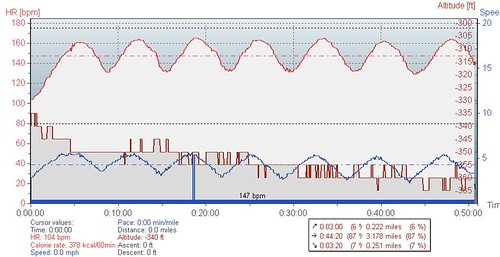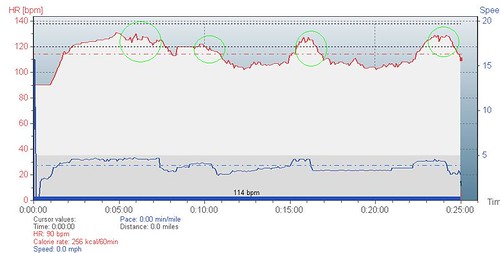Stress Test
I had my stress test yesterday. The good news is that it did not show any problems. The bad news is that the doctor did not let it go very far.
For those of you, who have never had a stress test, let me describe the procedure. Electrodes (sorry, I did not count how many) are placed on the chest and abdomen. These electrodes are connected via wires with a unit that is strapped to your waist. This unit is then connected to an electrocardiograph device which maps your heart's response. You perform the test on a treadmill, although sometimes a stationary bike is used. If the doctor is trying to measure oxygen intake you wear a face mask connected to a device that measures the oxygen flow into your lungs. The doctor will take your blood pressure and then the test will start. The treadmill starts slow and then speeds up in three minute increments. Most stress tests are done according to the Bruce Protocol. Below is list of the stages of the protocol. Each stage lasts three minutes.
Stage 1: 1.7 mph, 10% grade
Stage 2: 2.5 mph, 12% grade
Stage 3: 3.4 mph, 14% grade
Stage 4: 4.2 mph, 16% grade
Stage 5: 5.0 mph, 18% grade
Stage 6: 5.5 mph, 20% grade
Stage 7: 6.0 mph, 22% grade
The advantage of the Bruce protocol is that most people cannot sustain stage seven for three minutes, so usually a doctor can get a reading for maximum heart rate and VO2 max (maximum intake of oxygen). I went up to stage three before the doctor decided it was good enough. I estimate that I probably could go up to stage 5, but no farther. Fit athletes can usually go to stage 6 and possibly 7.
After the test my doctor seemed to think that my discomfort from Monday was a pulled muscle or at least something other than my heart. That was good to hear, but I know that it wasn't a torn muscle. I brought some printouts from my heart rate monitor to show him. I have reproduced them below.

This first chart is of a normal interval run I did on a treadmill. It is actually a very nice curve. The line is smooth and responds amazingly quickly to the change in speed. Isn't the human body amazing?! Notice how my heart easily goes up to 160 bpm and the recovers nicely.

But here is a copy of my run on Monday. The circles in green are the trouble spots. The line starts out nice, but then after going 5 mph for a while, I run into trouble. My heart refuses to cross the 130 bpm mark and I start to feel pressure in my chest. I am forced to slow down, so you can see the speed declines. You can notice that the line is actually quite erratic at the peak. After recovery I tried it again with the same results. After showing his chart to my doctor, he wanted me to see a Cardiologist. That is not what I wanted to hear.
What I wanted him to say was that this is normal and that I was probably just stressed or tired. Hopefully that is what the cardiologist will say. I was really looking forward to get back into training, and more delays are not what I need. I figured it was okay to go for a swim, since swimming doesn't raise your heart rate as much as running. So I went to the gym and did a nice and slow thirty laps. That felt good!
For those of you, who have never had a stress test, let me describe the procedure. Electrodes (sorry, I did not count how many) are placed on the chest and abdomen. These electrodes are connected via wires with a unit that is strapped to your waist. This unit is then connected to an electrocardiograph device which maps your heart's response. You perform the test on a treadmill, although sometimes a stationary bike is used. If the doctor is trying to measure oxygen intake you wear a face mask connected to a device that measures the oxygen flow into your lungs. The doctor will take your blood pressure and then the test will start. The treadmill starts slow and then speeds up in three minute increments. Most stress tests are done according to the Bruce Protocol. Below is list of the stages of the protocol. Each stage lasts three minutes.
Stage 1: 1.7 mph, 10% grade
Stage 2: 2.5 mph, 12% grade
Stage 3: 3.4 mph, 14% grade
Stage 4: 4.2 mph, 16% grade
Stage 5: 5.0 mph, 18% grade
Stage 6: 5.5 mph, 20% grade
Stage 7: 6.0 mph, 22% grade
The advantage of the Bruce protocol is that most people cannot sustain stage seven for three minutes, so usually a doctor can get a reading for maximum heart rate and VO2 max (maximum intake of oxygen). I went up to stage three before the doctor decided it was good enough. I estimate that I probably could go up to stage 5, but no farther. Fit athletes can usually go to stage 6 and possibly 7.
After the test my doctor seemed to think that my discomfort from Monday was a pulled muscle or at least something other than my heart. That was good to hear, but I know that it wasn't a torn muscle. I brought some printouts from my heart rate monitor to show him. I have reproduced them below.

This first chart is of a normal interval run I did on a treadmill. It is actually a very nice curve. The line is smooth and responds amazingly quickly to the change in speed. Isn't the human body amazing?! Notice how my heart easily goes up to 160 bpm and the recovers nicely.

But here is a copy of my run on Monday. The circles in green are the trouble spots. The line starts out nice, but then after going 5 mph for a while, I run into trouble. My heart refuses to cross the 130 bpm mark and I start to feel pressure in my chest. I am forced to slow down, so you can see the speed declines. You can notice that the line is actually quite erratic at the peak. After recovery I tried it again with the same results. After showing his chart to my doctor, he wanted me to see a Cardiologist. That is not what I wanted to hear.
What I wanted him to say was that this is normal and that I was probably just stressed or tired. Hopefully that is what the cardiologist will say. I was really looking forward to get back into training, and more delays are not what I need. I figured it was okay to go for a swim, since swimming doesn't raise your heart rate as much as running. So I went to the gym and did a nice and slow thirty laps. That felt good!



0 Comments:
Post a Comment
<< Home